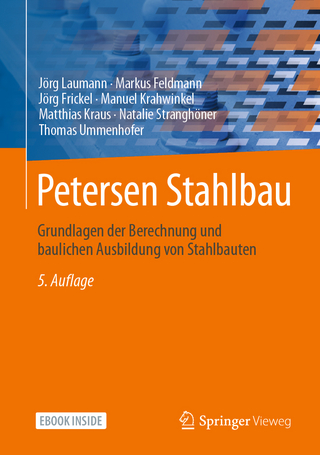
Petroleum Reservoir Rock and Fluid Properties
Crc Press Inc (Verlag)
978-0-8493-3043-8 (ISBN)
- Titel erscheint in neuer Auflage
- Artikel merken
A strong foundation in reservoir rock and fluid properties is the backbone of almost all the activities in the petroleum industry. Petroleum Reservoir Rock and Fluid Properties offers a reliable representation of fundamental concepts and practical aspects that encompass this vast subject area. The book provides up-to-date coverage of various rock and fluid properties using derivations, mathematical expressions, and various laboratory measurement techniques. Focused on achieving accurate and reliable data, it describes coring methods used for extracting samples from hydrocarbon formations and considerations for handling samples for conventional and special core analyses.
Detailing properties important to reservoir engineering and surface processing, the author emphasizes basic chemical and physical aspects of petroleum reservoir fluids, important phase behavior concepts, fluid sampling, compositional analysis, and assessing the validity of collected fluid samples. The book also presents PVT equipment, phase behavior analysis using laboratory tests, and calculations to elucidate a wide range of properties, such as hydrocarbon vapor liquid equilibria using commonly employed equations-of-state (EOS) models.
Covering both theoretical and practical aspects that facilitate the solution of problems encountered in real life situations, Petroleum Reservoir Rock and Fluid Properties is ideal for students in petroleum engineering, including those coming from different backgrounds in engineering. This book is also a valuable reference for chemical engineers diversifying into petroleum engineering and personnel engaged in core analysis, and PVT and reservoir fluid studies.
INTRODUCTION
The Formation of Petroleum Reservoirs
Typical Characteristics of Petroleum Reservoirs
The Significance of Petroleum Reservoir Rock and Fluid Properties
PREAMBLE TO PETROLEUM RESERVOIR ROCK PROPERTIES
Introduction
Coring Methods
Important Issues Related to Coring Methods
Types of Cores
Allocation of Core Data for Measurement of Reservoir Rock Properties
Handling of Reservoir Rock Core Samples
Types of Core Tests
POROSITY
Significance and Definition
Types of Porosities
Classification of Porosity
Parameters that Influence Porosity
Laboratory Measurement of Porosity
Non-Conventional Methods of Porosity Measurements
Averaging of Porosity
Examples of Typical Porosities
ABSOLUTE PERMEABILITY
Significance and Definition
Mathematical Expression of Permeability - Darcy's Law
Dimensional Analysis of Permeability and Definition of a Darcy
Application of Darcy's Law to Inclined Flow and Radial Flow
Averaging of Permeabilities
Permeability of Fractures and Channels
Darcy's Law in Field Units
Laboratory Measurement of Absolute Permeability
Factors Affecting Absolute Permeability
Porosity and Permeability Relationships
Permeabilities of Different Types of Rocks
MECHANICAL AND ELECTRICAL PROPERTIES OF RESERVOIR ROCKS
Introduction
Mechanical Properties
Electrical Properties
FLUID SATURATIONS
Significance and Definition
Distribution of Fluid Saturations in a Petroleum Reservoir
Definition and Mathematical Expressions for Fluid Saturation
Reservoir Rock Samples Used for Fluid Saturation Determination
Laboratory Measurement of Fluid Saturation
Assessing the Validity of Fluid Saturation Data Measured on the Plug End Trim for the Core Plug Sample
Special Types of Fluid Saturations
Saturation Averaging
Factors Affecting Fluid Saturation Determination
INTERFACIAL TENSION AND WETTABILITY
Introduction and Fundamental Concepts
Interfacial and Surface Tension
Wettability
Fundamental Concepts of Wettability
A Discussion on Practical Aspects of Wettability
Measurement of Reservoir Rock Wettability
Factors Affecting Wettability
Relationship between Wettability, Irreducible Water Saturation, and Residual Oil Saturation
CAPILLARY PRESSURE
Introduction
Basic Mathematical Expression of Capillary Pressure
The Rise of Liquid in Capillaries
Dependence of Capillary Pressure on Rock and Fluid Properties
Capillary Pressure and Saturation History
Laboratory Measurement of Capillary Pressure
Characteristics of Capillary Pressure Curves
Converting Laboratory Capillary Pressure Data to Reservoir Conditions
Averaging Capillary Pressure - the 'J' Function
Calculation of Permeability from Capillary Pressure
Effect of Wettability on Capillary Pressure
Practical Application of Capillary Pressure
RELATIVE PERMEABILITY
Fundamental Concepts of Relative Permeability
Mathematical Expressions for Relative Permeability
Salient Features of Gas-Oil and Water-Oil Relative Permeability Curves
Laboratory Measurement of Relative Permeability
Determination of Relative Permeability from Capillary Pressure Data
Factors Affecting Relative Permeability Measurements
Peculiarities of Relative Permeability Data
Assessing the Validity of Relative Permeability Data and Determination of Corey Exponents
Significance of Relative Permeability Data
Three-Phase Relative Permeability
INTRODUCTION TO PETROLEUM RESERVOIR FLUIDS
Introduction
Chemistry of Petroleum
The Solid Components of Petroleum
Classification of Reservoir Gases and Oils
Five Reservoir Fluids
Formation Waters
INTRODUCTION TO PHASE BEHAVIOR
Introduction
Definition of Terms Used in Phase Behavior
Phase Behavior of a Pure Component
Phase Behavior of Two-Component or Binary Systems
Phase Behavior of Multicomponent Mixtures
Construction of Phase Envelopes
PHASE BEHAVIOR OF PETROLEUM RESERVOIR FLUIDS
Introduction
Preamble to the Phase Behavior of Petroleum Reservoir Fluids
A brief Description of the Plus Fraction
Classification and Identification of Fluid Type
Black Oils
Volatile Oils
Gas Condensates
Wet Gases
Dry Gases
Behavior of Petroleum Reservoir Fluids in the Two-Phase Region
SAMPLING OF PETROLEUM RESERVOIR FLUIDS
Introduction
Practical Considerations of Fluid Sampling
Methods of Fluid Sampling
Evaluating the Respresentativity of Fluid Samples - Quality Checks
Factors Affecting Sample Representativity
COMPOSITIONAL ANALYSIS OF PETROLEUM RESERVOIR FLUIDS
Introduction
Strategy of Compositional Analysis
Characteristics of Reservoir Fluid Composition
Gas Chromatography
True Boiling-Point Distillation
Characterization of Pseudo Fractions and Residue
Other Nonconventional Methods of Compositional Analysis
PVT ANALYSIS AND RESERVOIR FLUID PROPERTIES
Introduction
Properties of Petroleum Reservoir Fluids
Laboratory Tests
Adjustment of Black Oil Laboratory Data
Other Sources of Obtaining the Properties of Petroleum Reservoir Fluids
VAPOR-LIQUID EQUILIBRIA
Introduction
Ideal Solution Principle
Empirical Correlations for Calculating Equilibrium Ratios for Real Solutions
Equations-of-State (EOS) Models
Use of EOS Models in PVT Packages
PROPERTIES OF FORMATION WATERS
Introduction
Compositional Characteristics of Formation Water
Bubble Point Pressure of Formation Water
Formation Volume Factor of Formation Water
Density of Formation Water
Viscosity of Formation Water
Solubility of Hydrocarbons in Formation Water
Solubility of Formation Water in Hydrocarbons
Compressibility of Formation Water
| Erscheint lt. Verlag | 23.2.2006 |
|---|---|
| Zusatzinfo | 13 Tables, black and white; 178 Illustrations, black and white |
| Verlagsort | Bosa Roca |
| Sprache | englisch |
| Maße | 156 x 235 mm |
| Gewicht | 839 g |
| Themenwelt | Technik ► Bauwesen |
| ISBN-10 | 0-8493-3043-2 / 0849330432 |
| ISBN-13 | 978-0-8493-3043-8 / 9780849330438 |
| Zustand | Neuware |
| Haben Sie eine Frage zum Produkt? |
aus dem Bereich



